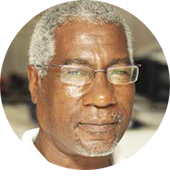
THE big crime talk across Saint Lucia this past week was about people killing people over animals, that after three persons were shot and two men were killed for three goats in Marc, a small community just outside Castries city – and that too after a Vieux Fort man was said to have been beheaded over a horse.
These fatal incidents were largely seen and treated as the senseless crimes they were in a country growing increasingly restless about gun crime. Likewise, in the Cooperative Republic of Guyana, but the Marc incident would also have been viewed with different eyes there.
Marc was historically dominated by Saint Lucians of East Indian descent and this case involves the deaths of the son of a mother of Indian descent and her husband of African descent.
No one here has made reference to the race of anyone involved.
But in Guyana, there would most likely have been references (in the press, including photographs and public comments) about the inter-racial elements — persons of different races representing the dominant races represented by the two dominant parties, the dominant racial composition of the community, etc.
Not that Guyanese are just simply plain racial or racist (which terms I use quite loosely here…).
Not that either dominant party is driven by policies based in race.
Not that the press there is racist either.
But actions and statements based on and/or in reference to race come natural in Guyana, where the two dominant races have been divided mainly over politics, religion and culture for longer than the over five decades CARICOM’s biggest country has been independent.
Guyanese of East Indian descent will easily call or refer to fellow Guyanese of African descent as everything from ‘Negro’ to ‘Black’ to ‘African’; and the Afro-Guyanese would just as easily refer to the Indo-Guyanese as everything from ‘Coolie’ to ‘East Indian’.
In a land of five major races, Guyanese of Portuguese descent are still simply described as ‘Putagee’ and those of Chinese descent as ‘Chinee’. And Amerindians, though representing as many as nine tribal nations, are commonly referred to as ‘Buck people’ or simply a ‘Bok’ man, woman or child.
But hardly does any average person of any race take offense or umbrage at or feel insulted by being described by any of those labels that the average Caribbean Community (CARICOM) citizen would probably find problems with, especially in this age of ‘political correctness’ and de-emphasizing labeling of minorities or identifiable groups of human beings.
This is simple plain talk in any of Georgetown’s major markets in Bourda or Kitty, La Penitence or Stabroek.
Guyana’s history and politics are driven more by its unique demographics than its equally unique geopolitics, both of which are totally strange to average CARICOM citizens from islands where one race dominates by the most significant overwhelming majority.
Trinidad & Tobago also has its share of racial and religious factors that affect its politics and culture through a carnival of confluences, as does Suriname.
But none is as expressive as Guyana has been since racial divisions were introduced in the 1960s as part of a grand plan by Britain and the USA to destabilize the popular People’s Progressive Party (PPP) that united people of both major races and all religions and cultures behind one political party, led by Cheddi Jagan and Forbes Burnham.
Supporters of both major parties play the race card, whether through continuation of inherited traditional practices or deliberate application of individual powerful influences in ways and for reasons that translate with racial overtones for political reasons.
The race issue comes up almost everywhere in Guyana, even in the most unusual places.
CARICOM citizens, including those schooled in diplomacy and protocol, will most likely refuse to accept that anyone would want to characterize a judge or magistrate (openly or quietly) by his or her complexion or appearance, far less to identify any with any political party.
But not in Guyana, where learned men and women across the legal and judicial spectrum will, from time to time, be openly and loudly described as an ‘Afro Guyanese ‘or ‘Indo-Guyanese’ Chief Justice, judge or magistrate. Fair as their judgments may be, too, there will always be many who will openly or privately weigh that judgement based on how the person on the bench looks.
The current Acting Chief Justice is Afro-Guyanese and judges are of both African and Indian heritage. But the Chairperson of the Guyana Elections Commission, retired judge Justice Claudette Singh, finds herself classified by many as ‘Indo-Guyanese’, whereas her Christian name reveals she might very well also have ‘Afro-Guyanese’ blood in her veins.
Be that or whatever as it may, there are also those very many Guyanese who will measure judges’ rulings, not as much by virtue of their legal merit as by which party was in office and who was President when they were appointed.
It just comes like natural… The same people will look at the same person but will see him or her with different eyes – and in accordance with the viewer’s own views and/or positions on race and politics.
It’s a sort of inherent and inherited mechanical way of thinking, watching and seeing that most people simply but gravely grew-up with in a society where many un-likes coexist only because there’s nowhere else to go.
There’s much peace and love and inter-racial harmony too, but all that fizzles into senseless nothingness at every election.





